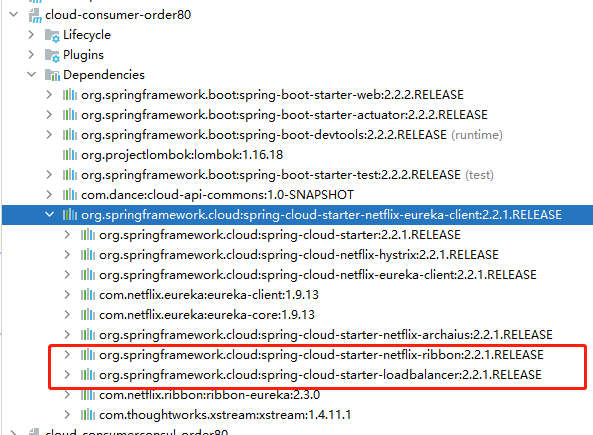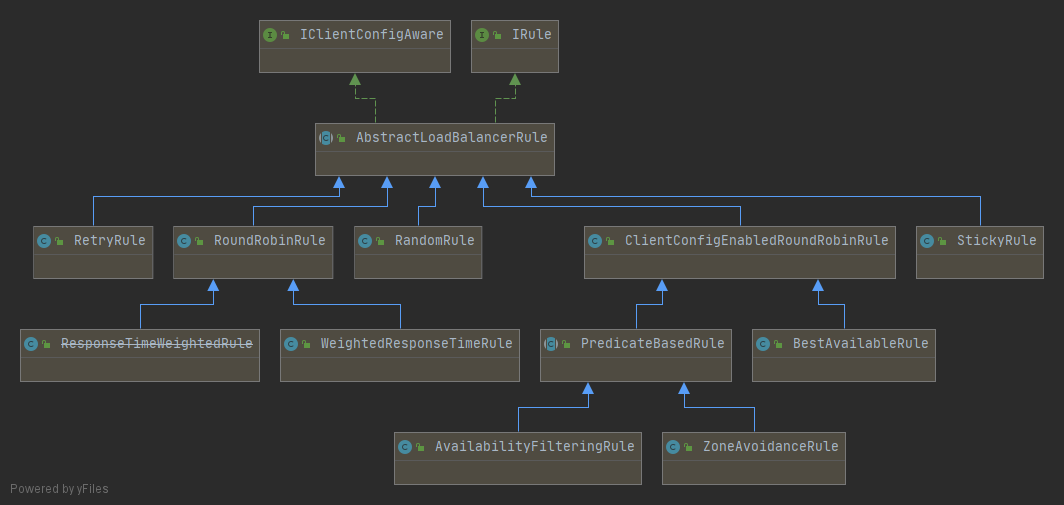Ribbon入门介绍
Spring Cloud Ribbon是基于Netflix Ribbon实现的一套客户端负载均衡的工具。
简单的说,Ribbon是Netflix发布的开源项目,主要功能是提供客户端的软件负载均衡算法和服务调用。Ribbon客户端组件提供一系列完善的配置项如连接超时,重试等。
简单的说,就是在配置文件中列出Load Balancer(简称LB)后面所有的机器,Ribbon会自动的帮助你基于某种规则(如简单轮询,随机连接等)去连接这些机器。我们很容易使用Ribbon实现自定义的负载均衡算法。
Ribbon目前也进入维护模式。
Ribbon未来可能被Spring Cloud LoadBalacer替代。
LB负载均衡(Load Balance)是什么
简单的说就是将用户的请求平摊的分配到多个服务上,从而达到系统的HA (高可用)。
常见的负载均衡有软件Nginx,LVS,硬件F5等。
Ribbon本地负载均衡客户端VS Nginx服务端负载均衡区别
Nginx是服务器负载均衡,客户端所有请求都会交给nginx,然后由nginx实现转发请求。即负载均衡是由服务端实现的。
Ribbon本地负载均衡,在调用微服务接口时候,会在注册中心上获取注册信息服务列表之后缓存到JVM本地,从而在本地实现RPC远程服务调用技术。
集中式LB
即在服务的消费方和提供方之间使用独立的LB设施(可以是硬件,如F5, 也可以是软件,如nginx),由该设施负责把访问请求通过某种策略转发至服务的提供方;
进程内LB
将LB逻辑集成到消费方,消费方从服务注册中心获知有哪些地址可用,然后自己再从这些地址中选择出一个合适的服务器。
Ribbon就属于进程内LB,它只是一个类库,集成于消费方进程,消费方通过它来获取到服务提供方的地址。
一句话
负载均衡 + RestTemplate调用
Ribbon的负载均衡和Rest调用
架构说明
总结:Ribbon其实就是一个软负载均衡的客户端组件,它可以和其他所需请求的客户端结合使用,和Eureka结合只是其中的一个实例。

Ribbon在工作时分成两步:
- 第一步先选择EurekaServer ,它优先选择在同一个区域内负载较少的server。
- 第二步再根据用户指定的策略,在从server取到的服务注册列表中选择一个地址。
其中Ribbon提供了多种策略:比如轮询、随机和根据响应时间加权。
POM.xml
先前工程项目没有引入spring-cloud-starter-ribbon也可以使用ribbon。
测试
- 启动Eureka集群
- 启动8001和8002工程
- 启动80Order工程

访问消费者接口测试
http://localhost/consumer/payment/get/1


已经实现本地负载轮询
不对呀,我们并没有引入Ribbon
因为Eureka在新版中已经默认引入了Ribbon

所以不需要我们单独引入
<dependency>
<groupld>org.springframework.cloud</groupld>
<artifactld>spring-cloud-starter-netflix-ribbon</artifactid>
</dependency>
RestTemplate的使用
getForObject() / getForEntity() - GET请求方法
getForObject():返回对象为响应体中数据转化成的对象,基本上可以理解为Json。
getForEntity():返回对象为ResponseEntity对象,包含了响应中的一些重要信息,比如响应头、响应状态码、响应体等
修改80工程Controller
@Slf4j @RestController public class OrderController { ......... public static final String PAYMENT_URL = "http://CLOUD-PAYMENT-SERVICE"; @Resource private RestTemplate restTemplate; ......... @GetMapping("/consumer/payment/getForEntity/{id}") public CommonResult<Payment> getPayment2(@PathVariable("id") Long id) { ResponseEntity<CommonResult> entity = restTemplate.getForEntity(PAYMENT_URL + "/payment/get/" + id, CommonResult.class); if (entity.getStatusCode().is2xxSuccessful()) { return entity.getBody();//getForObject() } else { return new CommonResult<>(444, "操作失败"); } } }
postForObject() / postForEntity() - POST请求方法

Ribbon默认自带的负载规则
lRule:根据特定算法中从服务列表中选取一个要访问的服务

- RoundRobinRule 轮询
- RandomRule 随机
- RetryRule 先按照RoundRobinRule的策略获取服务,如果获取服务失败则在指定时间内会进行重
- WeightedResponseTimeRule 对RoundRobinRule的扩展,响应速度越快的实例选择权重越大,越容易被选择
- BestAvailableRule 会先过滤掉由于多次访问故障而处于断路器跳闸状态的服务,然后选择一个并发量最小的服务
- AvailabilityFilteringRule 先过滤掉故障实例,再选择并发较小的实例
- ZoneAvoidanceRule 默认规则,复合判断server所在区域的性能和server的可用性选择服务器
Ribbon负载规则替换
修改cloud-consumer-order80
- 注意配置细节
- 官方文档明确给出了警告:
- 这个自定义配置类不能放在@ComponentScan所扫描的当前包下以及子包下,否则我们自定义的这个配置类就会被所有的Ribbon客户端所共享,达不到特殊化定制的目的了。(也就是说不要将Ribbon配置类与主启动类同包)
新建package - com.lun.myrule
在com.dance.myrule下新建MySelfRule规则类
package com.dance.myRule; import com.netflix.loadbalancer.IRule; import com.netflix.loadbalancer.RandomRule; import org.springframework.context.annotation.Bean; import org.springframework.context.annotation.Configuration; @Configuration public class MySelfRule { @Bean public IRule myRule() { return new RandomRule(); } }
主启动类添加@RibbonClient
package com.dance.springcloud; import com.dance.myRule.MySelfRule; import org.springframework.boot.SpringApplication; import org.springframework.boot.autoconfigure.SpringBootApplication; import org.springframework.cloud.netflix.eureka.EnableEurekaClient; import org.springframework.cloud.netflix.ribbon.RibbonClient; /** * Hello world! * */ @SpringBootApplication @EnableEurekaClient @RibbonClient(name = "CLOUD-PAYMENT-SERVICE", configuration = MySelfRule.class) public class OrderMain80 { public static void main( String[] args ){ SpringApplication.run(OrderMain80.class, args); } }
测试
- 启动Eureka集群
- 启动提供者集群
- 启动消费者
- 浏览器测试
测试成功,有时候是8001,有时候是8002,随机的
Ribbon默认负载轮询算法原理
默认负载轮训算法:
rest接口第几次请求数 % 服务器集群总数量 = 实际调用服务器位置下标,每次服务重启动后rest接口计数从1开始。
List<Servicelnstance> instances = discoveryClient.getInstances("CLOUD-PAYMENT-SERVICE");
如:
- List [0] instances = 127.0.0.1:8002
- List [1] instances = 127.0.0.1:8001
8001+ 8002组合成为集群,它们共计2台机器,集群总数为2,按照轮询算法原理:
- 当总请求数为1时:1%2=1对应下标位置为1,则获得服务地址为127.0.0.1:8001
- 当总请求数位2时:2%2=О对应下标位置为0,则获得服务地址为127.0.0.1:8002
- 当总请求数位3时:3%2=1对应下标位置为1,则获得服务地址为127.0.0.1:8001
- 当总请求数位4时:4%2=О对应下标位置为0,则获得服务地址为127.0.0.1:8002
如此类推…
RoundRobinRule源码分析
public interface IRule{ /* * choose one alive server from lb.allServers or * lb.upServers according to key * * @return choosen Server object. NULL is returned if none * server is available */ //重点关注这方法 public Server choose(Object key); public void setLoadBalancer(ILoadBalancer lb); public ILoadBalancer getLoadBalancer(); }
package com.netflix.loadbalancer; import com.netflix.client.config.IClientConfig; import org.slf4j.Logger; import org.slf4j.LoggerFactory; import java.util.List; import java.util.concurrent.atomic.AtomicInteger; /** * The most well known and basic load balancing strategy, i.e. Round Robin Rule. * * @author stonse * @author Nikos Michalakis <nikos@netflix.com> * */ public class RoundRobinRule extends AbstractLoadBalancerRule { private AtomicInteger nextServerCyclicCounter; private static final boolean AVAILABLE_ONLY_SERVERS = true; private static final boolean ALL_SERVERS = false; private static Logger log = LoggerFactory.getLogger(RoundRobinRule.class); public RoundRobinRule() { nextServerCyclicCounter = new AtomicInteger(0); } public RoundRobinRule(ILoadBalancer lb) { this(); setLoadBalancer(lb); } //重点关注这方法。 public Server choose(ILoadBalancer lb, Object key) { // 如果没有负载均衡 直接返回空 if (lb == null) { log.warn("no load balancer"); return null; } // 默认Server 为空 Server server = null; int count = 0; while (server == null && count++ < 10) { // 获取可以到达的服务器 List<Server> reachableServers = lb.getReachableServers(); // 获取所有服务器 List<Server> allServers = lb.getAllServers(); // 获取可达服务器数量 int upCount = reachableServers.size(); // 获取所有服务器数量 int serverCount = allServers.size(); // 如果可达服务器或者所有服务器其中有一个为0,那么直接返回空 if ((upCount == 0) || (serverCount == 0)) { log.warn("No up servers available from load balancer: " + lb); return null; } //获取返回的服务器下标 int nextServerIndex = incrementAndGetModulo(serverCount); // 从所有服务器中通过下标获取服务 server = allServers.get(nextServerIndex); // 如果服务等于空 if (server == null) { /* Transient. */ // 线程礼让 Thread.yield(); // 进入下一次循环 continue; } if (server.isAlive() && (server.isReadyToServe())) { // 返回Server return (server); } // Next. 将Server置空 server = null; } if (count >= 10) { log.warn("No available alive servers after 10 tries from load balancer: " + lb); } return server; } /** * Inspired by the implementation of {@link AtomicInteger#incrementAndGet()}. * * @param modulo The modulo to bound the value of the counter. * @return The next value. */ private int incrementAndGetModulo(int modulo) { for (;;) { // 传入所有服务器总数量 // 默认为0 在初始化的时候为0 int current = nextServerCyclicCounter.get(); // 当前请求数量 + 1 % 总数 获取下一个服务的下标 int next = (current + 1) % modulo;//求余法 // 通过CAS设置 if (nextServerCyclicCounter.compareAndSet(current, next)) return next; } } @Override public Server choose(Object key) { return choose(getLoadBalancer(), key); } @Override public void initWithNiwsConfig(IClientConfig clientConfig) { } }
Ribbon之手写轮询算法
自己试着写一个类似RoundRobinRule的本地负载均衡器。
修改提供者
- 7001/7002集群启动
- 8001/8002微服务改造- controller , 就是都加了一个接口,返回端口号的
@RestController @Slf4j public class PaymentController{ ... @GetMapping(value = "/payment/lb") public String getPaymentLB() { return serverPort;//返回服务接口 } ... }
修改配置类
@Configuration public class ApplicationContextConfig { // 应为是集群提供服务,所以需要本地负载 @Bean // 去掉注解 // @LoadBalanced public RestTemplate getRestTemplate(){ return new RestTemplate(); } }
修改主启动类
@SpringBootApplication @EnableEurekaClient //@RibbonClient(name = "CLOUD-PAYMENT-SERVICE", configuration = MySelfRule.class) public class OrderMain80 { public static void main( String[] args ){ SpringApplication.run(OrderMain80.class, args); } }
新增负载接口
package com.dance.springcloud.lb; import org.springframework.cloud.client.ServiceInstance; import java.util.List; /** * 本地负载均衡接口 */ public interface LoadBalancer { /** * ServiceInstance 就是 通过Discovery获取的服务实例集合 * @param serviceInstances 服务实例 * @return 可用的服务 */ ServiceInstance instances(List<ServiceInstance> serviceInstances); }
新增负载实现
package com.dance.springcloud.lb.impl; import com.dance.springcloud.lb.LoadBalancer; import org.springframework.cloud.client.ServiceInstance; import org.springframework.stereotype.Component; import java.util.List; import java.util.concurrent.atomic.AtomicInteger; /** * */ @Component//需要跟主启动类同包,或者在其子孙包下。 public class MyLB implements LoadBalancer { /** * 原子类 */ private AtomicInteger atomicInteger = new AtomicInteger(0); public final int getAndIncrement() { int current; int next; do { // 默认从 0 开始 current = this.atomicInteger.get(); // 如果 当前次数大于 最大的int 值直接返回 0 否则返回 当前 +1 next = current >= 2147483647 ? 0 : current + 1; // 如果CAS成功 } while (!this.atomicInteger.compareAndSet(current, next)); System.out.println("*****第几次访问,次数next: " + next); // 返回下标 return next; } //负载均衡算法:rest接口第几次请求数 % 服务器集群总数量 = 实际调用服务器位置下标 ,每次服务重启动后rest接口计数从1开始。 @Override public ServiceInstance instances(List<ServiceInstance> serviceInstances) { // 下标 % 服务实例数量 int index = getAndIncrement() % serviceInstances.size(); // 返回实例 return serviceInstances.get(index); } }
修改Controller
package com.dance.springcloud.controller; import com.dance.springcloud.entities.CommonResult; import com.dance.springcloud.entities.Payment; import com.dance.springcloud.lb.LoadBalancer; import lombok.extern.slf4j.Slf4j; import org.springframework.cloud.client.ServiceInstance; import org.springframework.cloud.client.discovery.DiscoveryClient; import org.springframework.http.ResponseEntity; import org.springframework.web.bind.annotation.*; import org.springframework.web.client.RestTemplate; import javax.annotation.Resource; import java.net.URI; import java.util.List; @Slf4j @RestController public class OrderController { //public static final String PAYMENT_URL = "http://localhost:8001"; // 将指定的地址修改为服务别名 服务别名从Eureka控制台查看 public static final String PAYMENT_URL = "http://CLOUD-PAYMENT-SERVICE"; @Resource private RestTemplate restTemplate; @Resource private LoadBalancer loadBalancer; @Resource private DiscoveryClient discoveryClient; 。。。。。。。。。。。。。。。。。。 @GetMapping(value = "/consumer/payment/lb") public String getPaymentLB() { // 获取服务实例结合 List<ServiceInstance> instances = discoveryClient.getInstances("CLOUD-PAYMENT-SERVICE"); if (instances == null || instances.size() <= 0) { return null; } // 调用自己的轮询算法 ServiceInstance serviceInstance = loadBalancer.instances(instances); URI uri = serviceInstance.getUri(); return restTemplate.getForObject(uri + "/payment/lb", String.class); } }
测试


测试成功~ 完结撒花
作者:彼岸舞
时间:2021�822
内容关于:Spring Cloud H版
本文属于作者原创,未经允许,禁止转发


